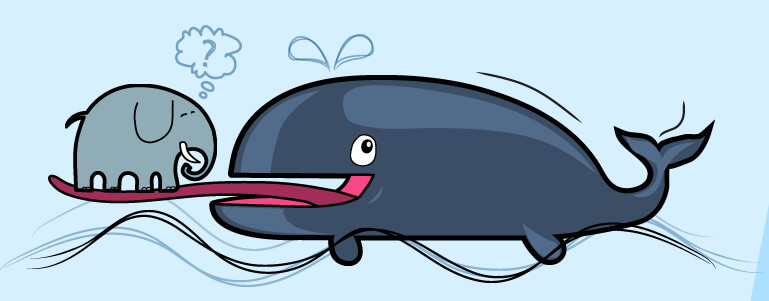The tongue of a blue whale weighs around 2.7 tons.
Blue whales are the largest animals ever known to have existed. They can grow up to 33 meters in length and weigh more than 180 metric tons.

As the largest animal alive, the Blue Whale has the largest instance of several body parts:
- Its tongue weighs around 2.7 tons
- Its mouth is large enough to hold up to 90 tonnes of food and water
- Its heart typically weighs 600 kg (1,320 lb) and can reach 900 kg in exceptional cases
- Its aorta is about 23 cm (9 in) in diameter
Blue whales were abundant in nearly all the oceans on Earth until the beginning of the twentieth century. For over 40 years, they were hunted almost to extinction by whalers until protected by the international community in 1966. A 2002 report estimated there were 5,000 to 12,000 blue whales left worldwide..
To love another species so vastly different from ourselves in body yet precisely the same inside is an experience of wonder and awe. With whales, perhaps it is the unexpected juxtaposition of their magnificent size and power along with their gentleness and acceptance of us that so disarms us and opens our hearts to new chambers of love and greater depths of forgiveness and trust. To be with whales up close (physically or spiritually) is transformative. It is healing and life-changing.
Like in any relationship of love, loving whales means to want the best for them. Love is the most powerful force in the universe. And sometimes to help those we love who are in peril, in addition to sending the energy of love from our hearts, our love also needs to be expressed in external, practical, grounded ways in the physical world. When we see a tragic car crash on the side of the road, we don’t just send love and keep driving. We stop to help, or at the very least call 911. With the overwhelming threats that whales currently face, there is much we can each do.
Praying for the whales
Praying for the Whales
As someone who loves whales with all of my heart and wants to be part of making the world a better place for them, I feel a responsibility to both seek and remain open to all information about them. Though my own skills and natural abilities lie in the communication and healing arts, it’s quite important to me that I also learn about their natural history; that I continue to learn from researchers and naturalists who spend their lives observing and furthering the body of knowledge that helps whales; that I support the rescue efforts of those who put themselves in harms way to stop whaling ships and to disentangle whales horrifically trapped in fishing gear; and that I keep abreast of how I can be part of political activism that changes laws and saves the lives of whales. Each of these fields brings us treasures of information and inspiration to further understand whales and how we can help them.
Everyone expresses their love for the whales differently. Some of us are more comfortable expressing our love from our hearts and spirits. Others are more capable and comfortable using their rational minds. It takes a village of great diversity to help the whales and to inspire others to care and act on their behalf. Artists, researchers, conservationists, naturalists, warriors, activists, healers, animal communicators, NGOs and government officials who allow themselves both reason and compassion in policymaking are all needed. In wanting a safe and harmonious world for the whales, perhaps we can create a harmonious world among ourselves as whale lovers. Rather than assume that our own particular contribution, skill set, profession or philosophy is the best or only one, or the one that has all the answers to help the whales, we can respect all paths.
